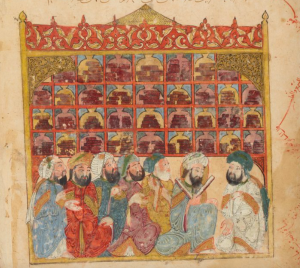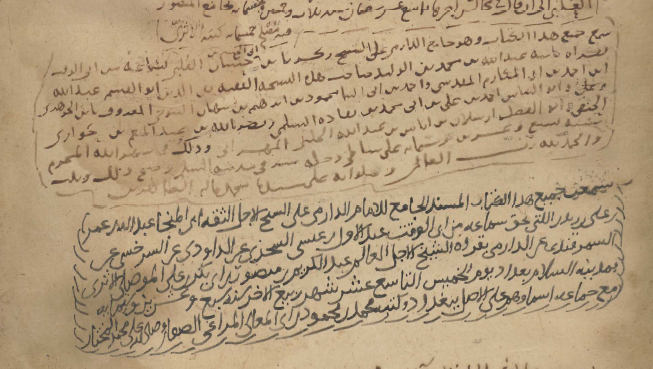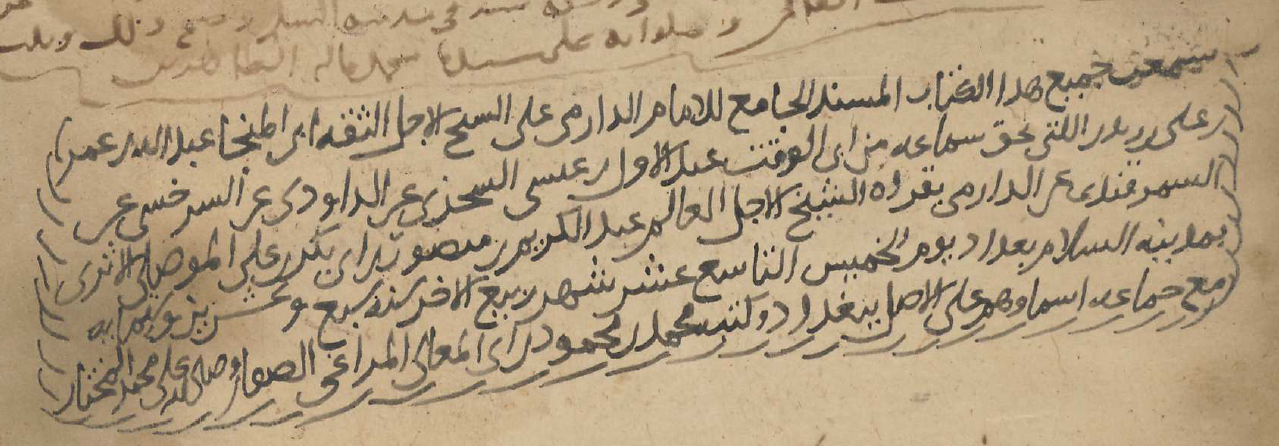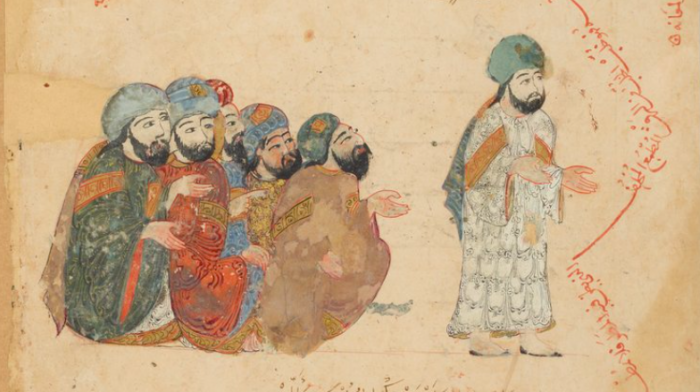About this manuscript
For background on al-Dārimī’s hadith collection, al-Musnad al-Jāmiʿ, see lesson 11. The present manuscript records a sixth-generation transmission (riwāya) from al-Dārimī's original: the manuscript was copied in the month of Shaʿbān 634 (April 1237), about 400 years after al-Dārimī (d. 255/869 or 250/864–5). Lesson 11 explored the transmission techniques which showed readers that the present manuscript traced directly to the original, but transmission recording alone was not a sufficient safeguard of the manuscript's integrity.
Anyone could transcribe an old copy of al-Dārimī’s al-Musnad al-Jāmiʿ and adduce a new edition. Without careful controls, therefore, many sub-standard volumes of poorly-transmitted hadith could emerge. Because hadith were precious memories of the Prophet and the basis for much Islamic law, maintaining quality was paramount, and hadith scholars expended great efforts to ensure the authenticity of their material, and they developed a system to further assure readers that their scholarly manuscripts accurately reflected the originals.
The touchstone of authenticity was orality: copyists needed to evidence that they had produced their manuscripts via an oral process in the presence of learned experts. The evidence they adduced was called the samāʿ note (or samāʿ certificate).

"The whole of this book was heard by...."
سمع جميع هذا الكتاب
And so begins the essential opening of the samāʿ note, recording orality in writing.
Samāʿ notes/tasmīʿ/ṭabaqa
The Arabic words samāʿ and tasmīʿ derive from the verb to ‘hear’: they are the most common technical terms of hadith scholars to label an oral recitation of the text by a shaykh before a gathering of students and scholars (or a reading aloud of a text by one of the audience to a shaykh who would identify corrections). A samāʿ note was a text added to the manuscript which provided the details of the oral recitation from which the book was recited (and the written copy verified). Ṭabaqa refers to the whole group of reciters, transcribers and listeners at the session.


Authoritative manuscripts should have notes of the samāʿ and details of the ṭabaqa, and manuscripts such as the present one, which were copied long after the original author, also would reproduce samāʿ notes of earlier transmissions of the text, to prove that each codex in which the text was transcribed since the aṣl (the original text) had been orally transmitted.
It is unclear when samāʿ notes first began to appear. They evidence the reading of a book in a formal and studious setting, and thus their popularity certainly increased when the madrasa became the standard location of study across the Muslim world from the eleventh century onwards (see Deroche, Islamic Codicology (al-Furqān, 2006) p. 334); but books written by tenth-century hadith scholars reveal an even earlier presence of samāʿ notes: al-Ḥākim al-Naysāburī (d. 405/1014) writes in his al-Madkhal ilā Kitāb al-Iklīl about ‘fake’ samāʿ certificates, which suggests that authentic ones had already become fairly standard (pp. 65-66). There are also some indications that late eighth-century hadith narrators were even then taking steps to record in writing the oral origin of their books (see al-Ṣayyāḥ, “al-Ṭibāq ʿind al-Muḥaddithīn”, Majallat al-Dirāsāt al-Islāmiyya 29 (2017) 37-72). Interestingly, the prevalence of samāʿ notes begins a steep decline in the sixteenth century, when collation statements (see lesson 13) continue to be made, but without reference to the presence of an audience.
Formalities: form and content of the samāʿ
Hadith scholars approached samāʿ notes somewhat like legal deeds. Since the purpose of the notes was to give readers a guarantee that the present manuscript accurately reproduced the author's original, the notes had to stand as testimony of authenticity for long periods of time. Like deeds, samāʿ notes communicated this authenticity by adhering to standardised wordings and formats which hadith scholars could instantly recognise as constituting a solid guarantee.
Medieval scholars describe to us the varied formal elements of the samāʿ; below I summarise opinions collected by the Egyptian hadith specialist and historian al-Sakhāwī (d. 902/1497) in his Fatḥ al-mughīth bi-sharḥ alfiyyat al-ḥadīth (Riyadh: Dār al-Minhāj 1426 AH, pp. 93-102).
Note Location: The samāʿ note was supposed to be clearly distinguished from the main text of the codex: al-Sakhāwī recommends it be written on the top margin of the first page (above the basmala), or at the very end of the text, or on a blank page inserted at the end of the codex. Some scholars felt it disrespectful to place the note above God’s name in the bismala, and it seems that in practice most concurred: samāʿ notes are usually found at the end of the codex, and some codices were bound with several blank folia at the back to enable the addition of samāʿ notes.
Prominence: some scholars opined that samāʾ notes must be clearly visible: presumably to enable a reader to quickly ascertain their presence and grasp the authoritativeness of the codex. On manuscripts, samāʿ notes are often found encased in wavy lines – perhaps this responds to the desire for automatic recognition.


Details: the note was supposed to record copious details such that subsequent readers could verify the persons involved and thereby judge the strength of the authenticity guarantee. The details also provided a grounding in reality: fixing the manuscript in a moment in time, at a particular place and in the presence of identifiable individuals. The identity of the shaykh who recited the text (al-musammiʿ) should be recorded fully, including his name, lineage, nisba, etc. Akin to a legal document, the names of the audience should be recorded as ‘witnesses’ that the book really was read aloud. Ideally, these witnesses should themselves be trustworthy scholars, and they should be identified with as full names as possible. Likewise, the note needed to include reference to the place and date of the reading, and other pertinent details.
Script: readers of manuscripts will note that the samāʿ notes are often written in idiomatic scripts that seem hard to read. This was deliberate: in keeping with the deed-like qualities of the document, the person who wrote the samāʿ note was enjoined to write in a way that reduced the chance of forgery. The writer should be a person of good repute and known to be trustworthy, and he should a person whose handwriting was known and identifiable. It seems that unscrupulous individuals were in the business of fabricating samāʿ notes to increase a manuscript’s value, and the stipulation that the samāʿ note be written in a difficult to copy hand by an individual whose handwriting could be cross-referenced provided a form of security. The writer of the samāʿ note was accordingly an important person, and biographical dictionaries sometimes recorded whether an individual was a known samāʿ writer.
Samāʾ notes in al-Dārimī’s al-Musnad
The first line of the first samāʿ note from the present manuscript of al-Dārimī’s al-Musnad opens thus:

قال الفقير إلى الله عبد الكريم بن منصور بن أبي بكر بن علي الموصلي الشافعي الأثري
"The one needful of God, ʿAbd al-Karīm son of Manṣūr son Abū Bakr son of ʿAli, from Mosul, of the Shafiite creed, traditionist by trade, says…"
Observe how the samāʿ note begins by the note's writer naming himself in a typically meticulous and specific fashion. Also note how the orthography is his own personal handrwiting which differs from a bookhand in various respects, particularly in the stark lack of letter pointing (see lesson 2).
Having identified himself, the writer of the samāʿ note turns to the manuscript, and since this text was written so long after al-Dārimī, the first order of business is to describe the samāʿ certificates of earlier transmissions, that prove this one legitimately carries on the tradition of oral recitation.

شاهدت على نسخة للدارمي صور طبقات بخط نور الدين عبد اللطيف بن بورنداز السلامي قد نقلها من الأصل اختصرت منها سماع الشيخ أبي الوقت من الداودي رحمهما الله وهي
"I witness that I have seen inscriptions of ṭabaqāt for the copy of al-Dārimī in the hand of Nūr al-Dīn ʿAbd al-Laṭīf ibn Burandāz al-Salāmī: he had copied them from the original; I suffice with a precis and give the samāʿ inscription for Shaykh Abū al-Waqt's narration of al-Dāwudī's transmission (God have mercy upon them) which goes as follows..."
Note how this begins with a formal language of witnessing. ʿAbd al-Karīm al-Mawṣilī only provides Abū al-Waqt’s samāʿ, this represents the transmission from the third to the fourth generation after al-Dārimī. The present manuscript itself represents the sixth generation of transmission, and hence ʿAbd al-Karīm’s note here reproduces a historical document – it does not refer to the samāʿ at which he was present and at which the manuscript was produced, rather it begins by preserving the samāʿ certificate from two generations earlier. If we consulted the actual manuscript which Abū al-Waqt possessed, the original note should appear. That earlier manuscript no longer exists, but hadith specialists treat the repetition of old samāʿ certificates by trustworthy witnesses as a preservation of the past, a process which gives antiquity to the present manuscript, making it embody the past history of the book.
Technically, each step of the transmission chain would have its own samāʿ certificate, and some hadith scholars might particularly have liked a manuscript in which every certificate was preserved. But these certificates are quite long, and ʿAbd al-Karīm dispenses with the first three, sufficing with his statement to have seen each of these as they were preserved in the earlier manuscript to which he refers.
ʿAbd al-Karīm’s certificate next gives his precis of the samāʿ certification from al-Dāwudī's manuscript which Abū al-Waqt had copied. This section ends by recording the dates of the two earlier transmissions:


...في جمادى الآخرة من سنة خمس وستين وأربعمائة وسمعه الداودي من الحموي في صفر سنة إحدى وثمانين وثلاثمائة كتبه الأثري
"...It was in the month of Jumādā al-Ākhira year 465 (Jan/Feb 1073), and al-Dāwūdī heard the text from Ḥammuwayh in the month of Ṣafar year 381 (Apr/May 991:). Al-Atharī wrote this."
The first of these two dates tells when Abū al-Waqt heard al-Dārimī’s al-Musnad from al-Dāwudī, and the second records when al-Dāwudī had heard it from Ḥammuwayh. At the end, our writer, ʿAbd al-Karīm, repeats the fact that he wrote this note (he refers to himself by his nisba ‘al-Atharī’ ‘the traditionist’) – this is another legalistic aspect: for the avoidance of doubt, he repeats reference to his act of recording the witness.
The next page of the manuscript (f. 284r) was left blank by the copyist in order to fill it with samāʿ notes. The first is again by ʿAbd al-Karīm al-Mawṣilī al-Atharī: this one copies (in precis) the samāʿ of the session in which Abū al-Waqt’s version of al-Musnad was heard by its transmitter, Abū Zakariyyā (the transmission from the fourth to fifth generation). This samāʿ ends with information on the place:


في مجالس آخرها تاسع عشر شعبان سنة ثلاث وخمسين وخمسمائة بجامع المنصور فيه مصلح خمسمائة كتبه الأثري
“[The book was read orally] in several sessions, the last of which was on the nineteenth of Shaʿbān year 553 at the Congregational Mosque of al-Manṣūr, in which […] of five hundred. Al-Atharī wrote this.”
And beneath this samāʿ is a third, also written by ʿAbd al-Karīm, identifying the session at which Abū Zakariyyā (the fifth-generation transmitter), orally presented the text to the narrator of the present version. Now we are at last approaching this manuscript’s present day...


سمع جميع هذا الكتاب وهو جامع الدارمي على الشيخ زكريا بن أبي الحسن بن حسان العلبي بسماعه من أبي الوقت بقراءة كاتبه عبد الله بن محمد بن الوليد صاحب هذه النسخة الفقيه تقي الدين أبو القاسم عبد الله...
“We, the undersigned heard all of this book – that is, the Jāmiʿ by al-Dārimī – transmitted by Shaykh Zakariyyā ibn Abī al-Ḥasan al-ʿUlbī from what he heard from Abū al-Waqt – read aloud from a text by its transcriber ʿAbd Allāh ibn Muḥammad ibn al-Walīd, the transmitter of this manuscript: the Jurist Taqī al-Dīn Abū al-Qāsim ʿAbd Allāh…. [the note continues with the names of other witnesses]”
This is the samāʿ session which produced the version of al-Dārimī's text which is recorded in the current manuscript, and it is the longest of the three notes we have explored, since it includes the names of all the witnesses. We recall that ʿAbd al-Karīm the samāʿ writer gave a ‘precis’ of the earlier samāʿ certificates – he left out the names of those earlier witnesses, merely alluding to them in his own testimony of having seen the "inscriptions of ṭabaqāt" noted above.
The final samāʿ we will explore is in a different hand:


سمعت جميع هذا الكتاب المسند الجامع للإمام الدارمي على الشيخ الأجل الثقة أبي المنجى عبد الله بن عمر بن علي بن زيد بن اللتي بحق سماعه من أبي وقت ... عن الدارمي بقراءة الشيخ الأجل العالم عبد الكريم بن منصور بن أبي بكر بن علي الموصلي الأثري...
I, the undersigned, heard the entirely of the this book – al-Musnad al-Jāmiʿ by the Imam al-Dārimī, under the venerable, trustworthy shaykh Abū al-Munajjā ʿAbd Allāh ibn ʿUmar ibn ʿAlī ibn Zayd ibn al-Latī, by his right of having heard it from Abū al-Waqt…from al-Dārimī. It was read aloud by the venerable, learned shaykh, ʿAbd al-Karīm ibn Manṣur ibn Abū Bakr ibn ʿAlī al-Mawṣilī al-Atharī…
This samāʿ refers another reading from Abū al-Waqt’s transmission of the text. Note that this reading was done by reading the text aloud in the presence of a shaykh (qirāʾa), and the reader of the text which was auditioned was ʿAbd al-Karīm, the one and the same writer of the previous samāʿ notes. It is for this reason that this samāʿ note is in a different hand: the formalities of the samāʿ note preferred that the ‘deed’ be written by someone other than the reader of the book itself. Again, the purpose is to enhance the solemnity of the samāʾ certificate as a legal-looking guarantee.
As is the case for deeds and legal documents across the world, the formalities established for samāʿ notes to attest the authenticity of hadith books are lengthy, complicated, and require practice to read fluently. They are, however, formulaic, as the repetition of accepted formuli is an essential aspect of their legitimacy. The present manuscript would be considered an excellent edition of al-Dārimī's al-Musnad on account of these meticulous details of the book's transmission over four generations.

Further Reading
T. Seidensticker, Audience Certificates in Arabic Manuscripts - the Genre and a Case Study. in Manuscript Cultures 8 (2015), 75-92.
Questions
-
Read the samāʾ note on the bottom on f. 284r (immediately below the last note we explored in the lesson). Identify the name of the shaykh and the transmission which was heard. Was it done from reading a text or reciting from memory, and how can we tell? Also identify the name of one of the witnesses, the approximate date, and the location of the reading session.
Assignments
-
Given the importance of the samāʾ certificate, its writer, the kātib, was an important figure in the scholarly community, and ideally, hadith scholars would nominate a prominent candidate whose identity could be ascertained by subsequent generations.
The kātib of several samāʾ certificates in this manuscript, ʿAbd al-Karīm son of Manṣūr son of Abū Bakr son of ʿAli, from Mosul, of the Shafiite creed, traditionist by trade, is known. What can you find about him in the medieval Arabic biographical dictionaries?
(Hint: Ibn al-Ṣābūnī’s Takmila ikmāl al-ikmāl and al-Dhahabī’s Tārīkh al-Islām have an entry about him)
